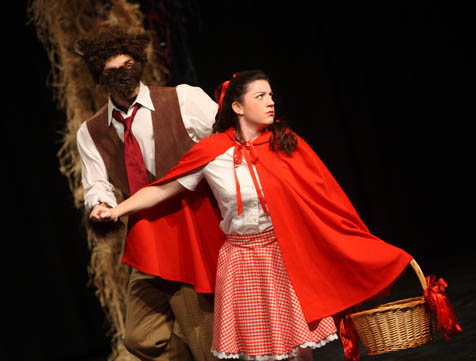
In Into the Woods, Stephen Sondheim takes some of the satirical feeling of A Funny Thing Happened on the Way to the Forum and mixes it with the moroseness of Sweeney Todd. Although the story revolves around famous fairy tale characters like Rapunzel and Little Red Riding Hood, the style remains equal parts comedy and morbidity-not unexpected from Sondheim. Westmont’s production of Into the Woods had all the most promising elements for a musical-an enticing storyline, talented voices, and a live orchestra-but in the end, these Wood fell short of being truly captivating.
As the play opens, three separate scenes are occurring simultaneously. The first two are well known-Cinderella and Jack and the Beanstalk-and their stories are progressing in the expected fashion: Cinderella (Brittney Brown) wants to go to the “festival” and Jack (Michael Bennett) needs to sell his cow. The third scene, however, is from an unknown story about a bread baker (Tyler Gregston) and his wife (Amanda Elliott). The couple longs for a child of their own but are hindered by a curse. Their neighbor, a witch, is responsible and, with a scheme in mind, promises to remove the curse if the bakers help her assemble the ingredients of her potion. The audience follows the two bakers as they search for the specific objects requested by the witch-a cow as white as milk, a cape as red as blood, hair as blond as corn, and a slipper as pure as gold-and in doing so, they link together the fairy tales in the other scenes, like Cinderella and Jack.
The aid of a full student orchestra brought a live and professional air to the musical compositions. However, there were times when the orchestra overpowered the vocals, leaving the lyrics anyone’s guess. In addition, the skill of the singers and musicians cannot make up for the lyrics and melodies, which are not among Sondheim’s most memorable. Although the play is equipped with the life lessons one might expect from generic fairy tales-“never give up,” “don’t blame others,” and “family is most important”-Into the Woods forgets a key lesson: Make plays that are captivating, and thus memorable.



